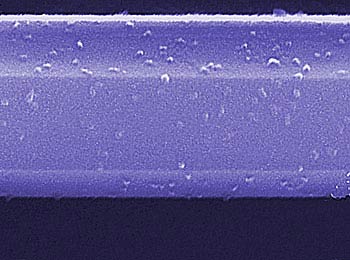A team of researchers from the National Institute of Standards and Technology (NIST), George Mason University, and the University of Maryland has made nano-sized sensors that detect volatile organic compounds—harmful pollutants released from paints, cleaners, pesticides, and other products—that offer several advantages over today’s commercial gas sensors, including low-power room-temperature operation and the ability to detect one or several compounds over a wide range of concentrations.
|
ADVERTISEMENT |
The recently published work is proof of concept for a gas sensor made of a single nanowire and metal oxide nanoclusters chosen to react to a specific organic compound. This work is the most recent of several efforts at NIST that take advantage of the unique properties of nanowires and metal oxide elements for sensing dangerous substances.

NIST scanning electron microscope image of a gas sensor segment fabricated of a semiconducting nanowire of gallium nitride.
Modern commercial gas sensors are made of thin, conductive films of metal oxides.
…
Add new comment